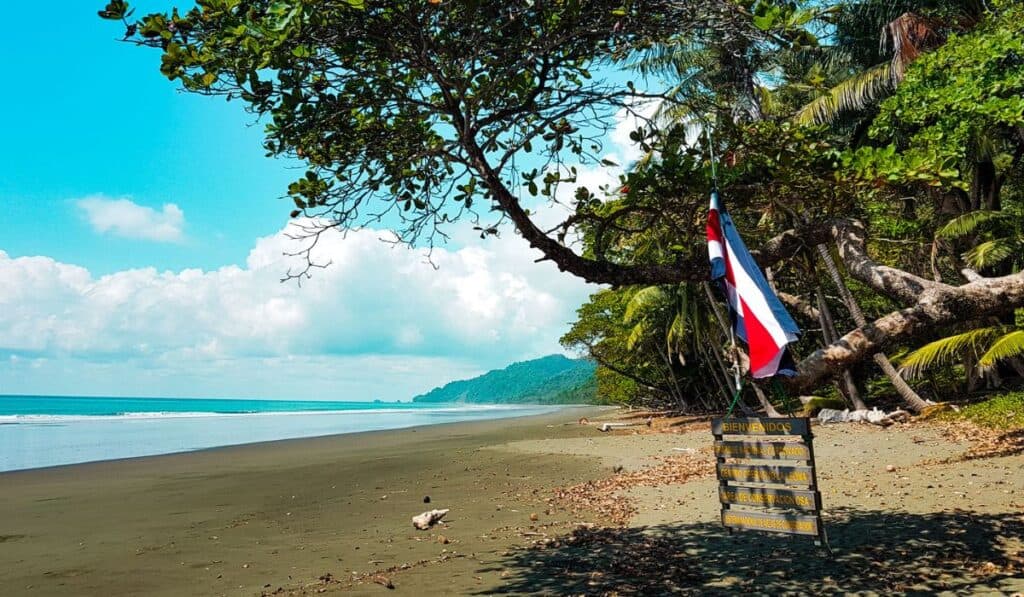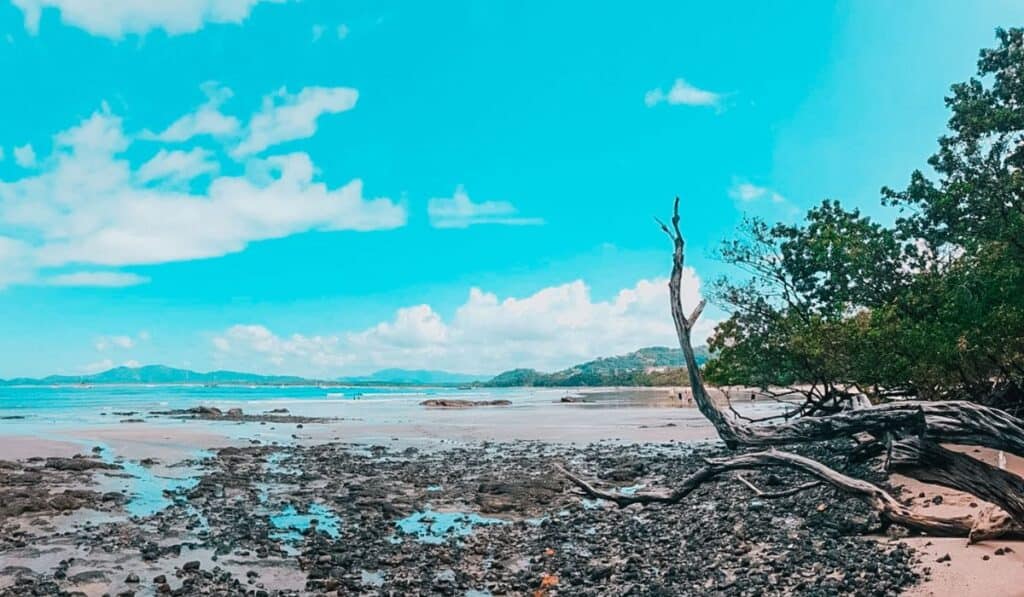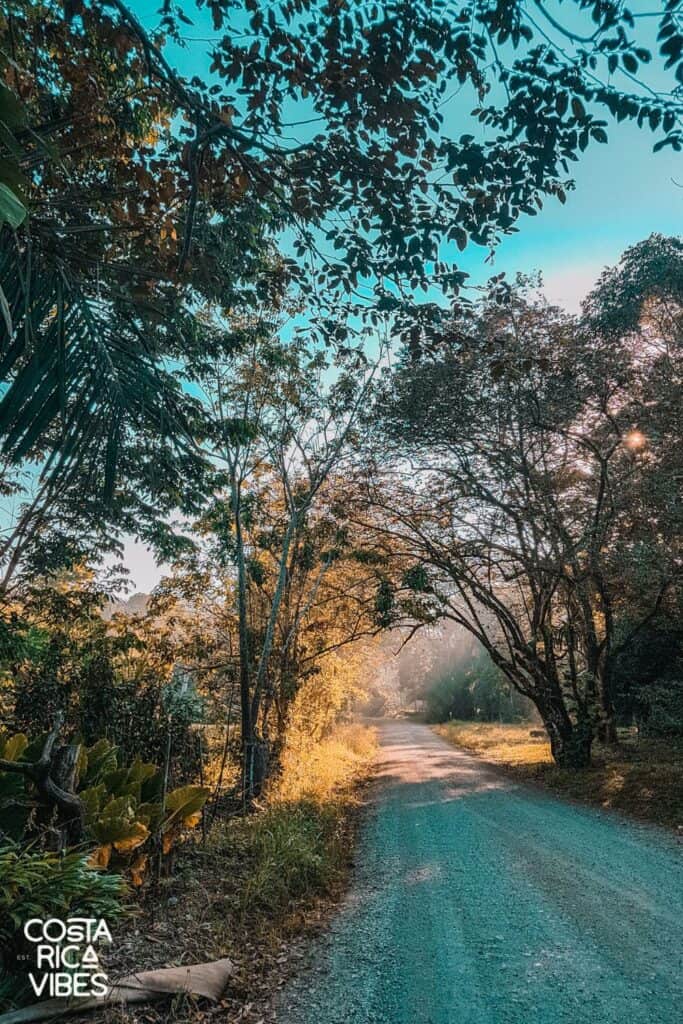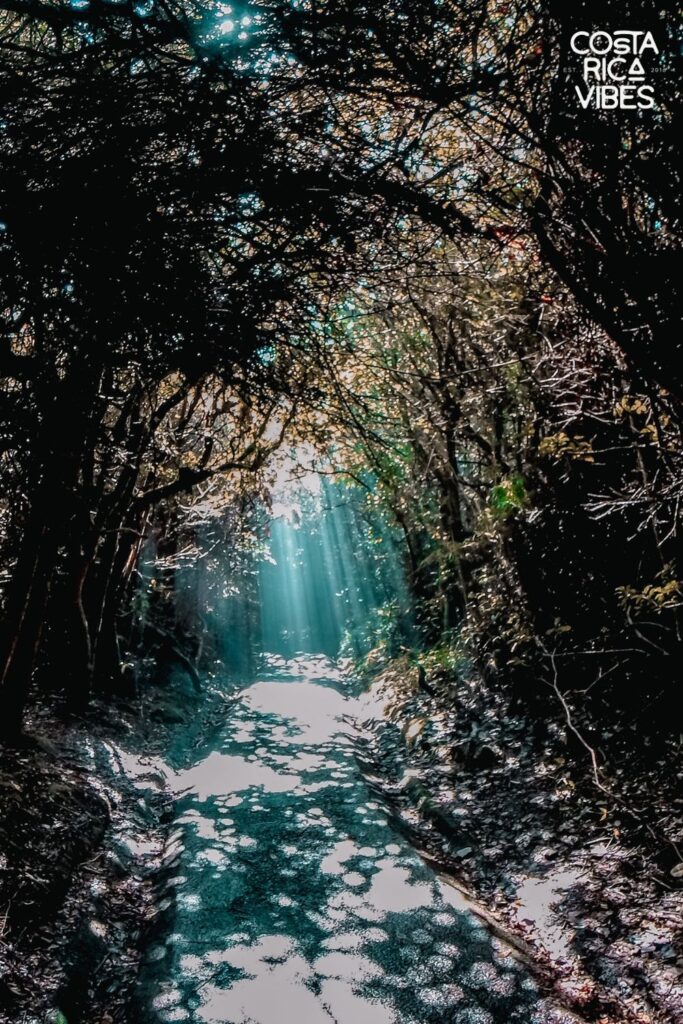Disclaimer: This article may contain affiliate links. Clicking on them may earn Costa Rica Vibes a commission, at no extra cost to you. Thank you for your support!
Costa Rica in January: Weather and Best Places to Visit
Should you visit Costa Rica in January?
January in Costa Rica is officially dry season! This time of year is often referred to as, “verano” or summer throughout most of the country. It is also one of the most popular months of the year to visit the country.
As people who live in Costa Rica, this is the month we always return from visiting our families in the cold after Christmas. It is always so nice to land in the sun and heat after the northern frigid weather. We are sure that you will feel the same way!
We created this guide to Costa Rica in January to give you an overview on what to expect of the weather by region, give you advice on how to make the most out of your trip, and fill you in on the holidays and festivities during this time.
Should You Visit Costa Rica in January?
We say yes! January is a great time to visit Costa Rica but, there are some things you should know first.
Let’s go through the pros and cons of January in Costa Rica to determine if it is the best time of year for you to plan your trip.
Pros of Visiting in January
- January is in the middle of Costa Rica’s dry season, especially in the Pacific region. This means that there will be almost zero rain and all sunny and hot days. Yay!
- Wildlife can be seen throughout the year in Costa Rica, but the dry season can make certain animals easier to spot. This is because they gather around water sources. You can see a variety of birds, monkeys, and other wildlife during this time.
- January is a good month for surfing, especially on the Pacific coast. With consistent swells and less rain, it’s great!
- With fewer clouds and rain during the dry season, January provides clearer skies for stargazing, particularly in areas away from the city lights.

Cons of Visiting in January
- Because this is peak tourist season, you’ll encounter larger crowds at popular destinations, such as beaches and national parks.
- Due to the increased demand, prices for accommodations, tours, and even some restaurants can be more expensive in January than in the off-peak season.
- Popular hotels, resorts, and tours can get fully booked well in advance for January. If you don’t plan ahead, you might miss out on your preferred choices. So, book early!
Tip: Book your rental car now and save 10% plus other perks - While the sunny weather is nice, it is important to be prepared for hotter temperatures. We find that it’s easy to get dehydrated at this time of year.
- The Costa Rican school year ends for summer vacation in December and doesn’t start again until late January. So a lot of locals will be traveling as well (roads are busier, more things are booked out etc.)
- The weather can be really windy, especially in the central part of the country.
Our Opinion
In our opinion, January is a great time to visit because you won’t have to deal with any rain and everything is still mostly green still.
However, you definitely should book things as early as possible. If you wait too long, all the affordable and nice hotels will be taken. This goes for transportation and activities as well.
Plus, the crowds at certain places like Manuel Antonio National Park are not ideal.
Overall, we still travel around the country during high season. We just try to go to more off-the-beaten-path parts of the country if possible.
Costa Rica Weather in January

January is part of the dry season throughout the country. However, Costa Rica’s weather can vary depending on where you go, After all, the country is home to several different microclimates.
Here is what you can expect from the weather in Costa Rica in January by region.
Caribbean Coast
The Caribbean coast of Costa Rica, which includes areas like Puerto Viejo, Cahuita, and Tortuguero, typically has an opposite weather pattern to that of the Pacific coast. Here’s what you can usually expect in January:
- Rain: January can be a month of heavy rainfall on the Caribbean coast. Short, intense showers are common, often during the late afternoon or evening.
- Temperature: Daytime temperatures are generally warm, with the average temperature ranging between 81°F to 88°F (27°C to 31°C ). Nights remain warm but can feel more comfortable with the coastal breeze.
- Humidity: The Caribbean side is known for its high humidity. It often feels muggy, especially after rainfall.
- Sunshine: January can have a mix of sunny and overcast days. While mornings can start off clear, clouds might roll in as the day advances, especially if rain is expected.
A few tips if you’re visiting the Caribbean coast in January:
- It’s a good idea to carry rain gear, such as a lightweight waterproof jacket or poncho. Quick-drying clothes can also be beneficial.
- Since the weather can be unpredictable here it is good to be flexible. If you see a clear morning, get out there and enjoy it. The Caribbean coast is great for watching the sunrise!
Our Story: A few years ago we decided to travel to Cahuita and Tortuguero in January with my dad and sister. It rained a lot in the evenings in Cahuita, but the day we arrived in Tortuguero it just poured. Torrential downpours all day long. Everything we owned got soaked. It also rained all night. All of Tortuguero was basically a mud pit from all the rain haha.
However, we woke up in the morning to blue skies and perfect weather right before our 6am Tortuguero National Park canoe tour. The weather than stayed perfect for the rest of the day.
So, the point is, you never really know here. It is probably not an ideal time to visit, but it’s not a bad place to go if you want to avoid the Pacific Coast crowds.
Guanacaste Province
Guanacaste, with popular spots like Tamarindo, Playas del Coco, and Playa Flamingo, is known for its sunny weather and beautiful beaches.
Here’s what January typically brings to this region:
- January falls within Guanacaste’s dry season. This means that rainfall is basically non-existent and many days are sunny from dawn to dusk. The landscape begins to transition from the lush green of the rainy season to a drier, golden hue.
- Temperature: Daytime temperatures are warm and can range from 82°F to 93°F (28°C to 34°C). Evenings can be slightly cooler, making it pleasant for beachside dinners and walks.
- Humidity: Relative to other parts of Costa Rica, Guanacaste tends to have lower humidity, especially in January. This is typically the driest area in the country.
- Sunshine: January is one of the sunniest months in Guanacaste. Expect clear blue skies, which are perfect for beach days, surfing, and other outdoor activities.
- Sea Conditions: The Pacific waters are warm, often around 81°F to 84°F (27°C to 29°C). The conditions are great for swimming, snorkeling, and surfing, though certain beaches might have stronger currents.
Our Experience:
We often come to Guanacaste in January because we love the good weather and scuba diving. Plus, we like that things are still somewhat green. By February, everything turns brown and dead here.
However, the crowds can be a bit much and they are kind of hard to avoid. Even the smaller beach towns around here get busy.
Central Valley
The Central Valley, with its vibrant cities, historic sites, and cooler mountainous climate, offers a different experience from Costa Rica’s coastal regions. Here’s the typical January weather is:
- Rain: January is within the dry season for the Central Valley, meaning there is basically no rain.
- Temperature: Due to its elevation, the Central Valley boasts milder temperatures. Daytime highs usually range between 72°F to 81°F (22°C to 27°C). Nights can be cooler, dropping to 59°F to 64°F (15°C to 18°C ).
- Humidity: The Central Valley has relatively moderate humidity compared to coastal regions, making it more comfortable.
- Sunshine: January is generally sunny and clear, especially in the mornings. Some afternoons might become partly cloudy, but it’s predominantly sunny overall.
- Wind: This area is known to have strong winds in the month of January.
A few tips if you’re visiting the Central Valley in January:
- Layer Up: Given the cooler evenings and mornings, it’s a good idea to have layers. A light jacket or sweater can be especially useful. I find by evening I am always wearing pants and a sweater.
Our Experience: We live in the Central Valley, so we have spent many January’s here.
I’ve got to say, I’m really not a fan of the winds at this time of year. They make it seem a lot cooler.
However, the clear views are great! If you visit this area you should definitely go to Poas Volcano or Irazu Volcano. In January you should have super clear crater views.
Central Pacific
The Central Pacific coast of Costa Rica is a blend of tropical beaches, lush rainforests, and a lot of wildlife. Here’s a detailed insight into January in this region:
- Rain: January is within the dry season for the Central Pacific. There should be absolutely no rain during your trip.
- Temperature: The temperatures are typically warm, with daytime highs ranging between 82°F to 91°F (28°C to 33°C). Nights are slightly cooler, but still comfortably warm.
- Humidity: Like much of Costa Rica, the Central Pacific region can be quite humid. While it may not be as consistently high as the Caribbean side, expect some days where the humidity is noticeable.
- Sunshine: January tends to be mostly sunny, especially in the mornings. Some afternoons might see scattered clouds, but clear, sunny days are more common this month.
- Sea Conditions: The ocean temperatures typically hover around 81°F to 84°F (27°C to 29°C). Swimming, snorkeling, and surfing conditions are generally great.
A few tips if you’re visiting the Central Pacific in January:
- Be Sun Smart: With so much sunshine expected, make sure to bring sunscreen, hats, and sunglasses for protection. Reapplying sunscreen, especially after swimming, is crucial. It’s crazy how easy it is to get sunburned here.
- Accommodations: January is a popular month for tourism in Costa Rica, including the Central Pacific region. It’s a good idea to book accommodations and tours in advance.
South Pacific
The South Pacific of Costa Rica (also known as the Osa Peninsula) offers a more untouched and wild experience compared to other regions. Here’s a snapshot of January in this area:
- Rain: The South Pacific is one of the wettest regions in Costa Rica. However, January is within the dry season, meaning there’s virtually no rainfall. That said, occasional showers can still occur, particularly in the rainforest areas.
- Temperature: Warm and tropical, daytime temperatures generally range between 81°F to 90°F (27°C to 32°C).
- Humidity: High humidity is common in the South Pacific due to the dense rainforests and coastal location. It can feel quite muggy, especially after short bursts of rain.
- Sunshine: January sees a good amount of sunny days. Mornings are often bright and clear, while afternoons might bring some clouds, especially closer to the rainforests.
- Sea Conditions: Ocean temperatures are warm. The water can be suitable for swimming, snorkeling, and surfing, but as always, it’s essential to be aware of local conditions, such as rip currents.
A few tips if you’re visiting the South Pacific in January:
- Wildlife Expeditions: The Osa Peninsula is often referred to as one of the most biodiverse places on Earth. January’s drier conditions can be ideal for exploring Corcovado National Park and spotting diverse wildlife.
- Travel Logistics: Some areas in the South Pacific can be more remote and challenging to access, especially the deeper parts of Osa. Make sure your travel logistics are sorted.
- Savor the Seclusion: The South Pacific is less developed in terms of tourism compared to other parts of Costa Rica. Enjoy the more secluded beaches and the untouched nature that this region offers.
Our Experience: A few years ago we had a few weeks in January with no plans. We decided to go away to the beach, but because it was peak high season and we hadn’t booked anything ahead of time we were a little unsure of where we should go.
So, we decided to head down to the Osa Peninsula and stay at a vacation rental on the beach near Puerto Jimenez. We booked a hotel like 4 days before we left and had no problem finding a place to stay.
And, it was great!
There were hardly any tourists down there, the weather conditions were perfect, and we go to do a lot of hiking through the Corcovado National Park rainforests.
So, basically I’m saying, if you want to see a lot of wildlife, enjoy nice beaches, and not contend with crowds; this might be the perfect place for you. The downside is that it is a long drive from San Jose.
The Northern Mountains
The Northern Mountains of Costa Rica, with their misty forests and iconic volcanoes, offer a mystical and refreshing contrast to the coastal regions. Here’s what January typically looks like in this area:
- Rain: January is part of the dry season in Costa Rica. However, given the cloud forest ecosystem, especially in Monteverde, occasional mists and drizzles are common. La Fortuna tends to be drier but can still experience sporadic rain showers.
- Temperature: The cooler altitudes bring milder temperatures. In La Fortuna, daytime average temperatures can range from 72°F to 82°F (22°C to 28°C). In the higher altitudes of Monteverde, it’s cooler, with highs between 64°F to 75°F (18°C to 24°C). Nights in both locations can be cooler, so bringing a jacket or sweater is advised.
- Humidity: While the region has its humid moments, especially in the cloud forests, it’s often offset by the cooler temperatures, making it feel more comfortable.
- Sunshine: January typically has clear mornings, perfect for activities and sightseeing. Cloud cover might increase as the day progresses, especially in Monteverde, leading to the signature misty ambiance.
- Wind: Monteverde in particular can be really windy at this time of year.
A few tips if you’re visiting the Northern Mountains in January:
- Layer Your Clothing: Given the range in temperatures, especially between day and night, layered clothing is advisable. A light rain jacket can also be handy.
- Book Early: January is a popular month for tourists, and places like Arenal and Monteverde can get busy. It’s a good idea to book accommodations and tours in advance.
Our Experience: We have visited La Fortuna a few times in January and I can’t remember ever having rain.
However, I expected the volcano to be clear every day that we were there since it is dry season, and that just wasn’t the case.
We were able to get some beautiful volcano views, but there have also been days in January when it was completely clouded over.
As for Monteverde, I actually don’t really like visiting here at this time of year.
It is the time of year with the best weather here. However, Monteverde is a cloud forest.
I think visiting here during the rainy season when there is somewhat consistent drizzles of rain and moody foggy weather really adds to its charms.
Nicoya Peninsula
The Nicoya Peninsula, with its idyllic beaches and vibrant coastal communities, is a haven for surfers, yogis, and beach enthusiasts. Here’s a snapshot of January in this region:
- Rain: January is firmly within the dry season for the Nicoya Peninsula. This means sunnier days and no rainfall.
- Temperature: True to its tropical beach setting, daytime temperatures hover between 28°C to 33°C (82°F to 91°F). Nights are comfortably warm, making it perfect for evening beach strolls.
- Humidity: While the peninsula can be humid, the consistent sea breezes, especially near the coast, help in making it feel more comfortable.
- Sunshine: Expect plenty of sunshine in January. Mornings are typically clear, with blue skies prevailing for most of the day.
- Sea Conditions: Ocean temperatures are inviting, generally ranging from 79°F to 82°F (26°C to 28°C ). January is also a popular month for surfing, with many spots on the peninsula offering excellent waves.
Our Opinion:
The Nicoya Peninsula is our favorite area in the country. However, it is somewhat hard to visit here in January because of the bigger crowds.
Santa Teresa becomes so full!
If you would like to visit here I suggest staying in Montezuma. It still gets crowded, but it is definitely less busy than Santa Teresa.
Fun Things to Do in Costa Rica in January

- Definitely hit up the beaches as often as you can. The water is so warm at this time of year. It’s amazing! Just note that sometimes it gets so hot that you can’t walk without sandals on the beach. Also, stay in the shade. Sunburns are no joke here. But don’t sit under trees with coconuts because they fall haha.
- January is a popular month for surfing. Head to spots like Playa Hermosa (south of Jaco), Dominical, or Pavones for some great waves.
- January is a fantastic time for bird watching, and you might spot animals like monkeys, sloths, and coatis.
- Trek through the cloud forests of Monteverde or hike around the Arenal Volcano. The dry weather makes trails more accessible.
- Relax in the natural thermal hot spring waters near Arenal Volcano. There are several resorts and natural spots where you can soak and unwind.
- Snorkeling and Diving: Head to the Pacific coast or take a trip to Isla del Caño or the Catalina Islands for some fantastic underwater views.
- River Rafting: Experience white-water rafting on rivers like the Pacuare or the Savegre. The water levels are more manageable and safer in January since the heavy rains have died down.
- Horseback Riding: Explore beaches or forests on horseback. Many places, especially beach towns, offer horseback riding as an activity.
- Caving: Discover the Venado Caves near La Fortuna, where you can witness stalactites, stalagmites, and even some bats!
- Fishing: Engage in sport fishing on the Pacific coast. January is a good month for catching species like marlin, sailfish, and dorado.
- January is the perfect time to watch the sunset. I mean, you should always watch the sunset on the Pacific Coast of Costa Rica, but January is an especially good time for this. We like to make dinner reservations for about 5:15pm at beach front restaurants so we can enjoy dinner with a sunset show.
What to Pack for Costa Rica in January
When packing for Costa Rica in January consider the following items:
Essentials:
- Passport & Copies: Have a digital backup stored securely.
- Travel Insurance Information: Always good for emergencies. Note: We suggest Hemondo for Costa Rica travel insurance. They are great!
- Local Currency (Colones): While USD is accepted in many places, local currency is handy. Find out more in our guide to currency.
- Debit/Credit Cards: Inform your bank prior to your journey.
- Adaptors/Converters: Costa Rica uses 110V, 60Hz electricity (the same as the United States).
Clothing:
- Lightweight Clothes: Breathable fabrics are ideal. Include both shorts and long pants.
- T-Shirts & Tank Tops
- Light Sweater or Jacket: Essential for cooler nights, especially in the Northern Mountains.
- Underwear & Socks: Quick-drying varieties are recommended.
- Swimwear: Ready for the beaches and pools.
- Hat & Sunglasses: Sun protection is crucial.
- Sturdy Sandals: For beach walks and casual strolls.
- Hiking Shoes/Boots: If you’re venturing into national parks or the mountains.
- Pajamas or Sleepwear.
Toiletries:
- Sunscreen: SPF 30 or higher is recommended.
- Insect Repellent: Useful against mosquitoes.
- Toothbrush, Toothpaste, and Floss.
- Shampoo, Conditioner & Soap: Consider biodegradable products.
- Deodorant.
- Personal Medications & First Aid Kit: Basics plus any personal prescriptions.
- Travel Towel: Quick-drying is best.
Gadgets:
- Camera: Don’t forget chargers and extra memory cards.
- Smartphone & Charger.
- Power Bank: Useful for outings.
- Waterproof Bags or Cases: Protect your devices from sudden showers.
- Headlamp or Flashlight: For nocturnal adventures or early morning treks.
Miscellaneous:
- Reusable Water Bottle: Important to stay hydrated.
- Daypack: Useful for excursions and day trips.
- Biodegradable Wet Wipes.
- Ziplock Bags: For snacks, gadget protection, and more.
- Snorkel Gear: Particularly if heading to the coast.
- Books or eReader: Relax and unwind during downtime.
- Binoculars: Enhance your wildlife viewing experience.
Check out our complete packing list for women and complete packing list for men for more details.
Booking Transportation in January


We suggest booking your transportation for Costa Rica in January as early as possible.
With transportation it is not so much about getting the best deals, but more so about getting any transportation at all.
See, the prices of rental cars and shuttles are usually set ahead of time, so the price won’t necessarily be lower if you reserve far in advance. However, things book out fast.
We work exclusively with a local rental car company called Adobe. They are our absolute favorite rental car company in Costa Rica and they have given us a 10% discount plus other perks to pass on to you.
They have a huge fleet of new vehicles, but during the peak travel season it is not unusual for them to be completely booked out. So, reserve as early as possible.

Adobe Rent-a-Car
- 10% discount for Costa Rica Vibes readers
- Free second driver
- 0% deductible on Liability Protection Insurance
- Excellent customer service
- New fleet of well-maintained vehicles
One of the many great things about Adobe is that they allow free cancellation. We suggest reserving as soon as possible and altering your reservation if your plans change.
In our opinion, having a rental car is always the best way to get around the country. It will give you the most flexibility and will allow you to enjoy fun day trips without depending on tours with transportation.
For January, you don’t usually need a 4×4 vehicle, but we suggest booking an SUV for decent clearance for hilly roads.
Another good way to get around is by shuttle. You can get a private shuttle quote from Adobe Transfers here.
For a shared shuttle to anywhere in the entire country, we usually have the best luck with Bookaway. They offer the widest selection of shared shuttles with reputable Costa Rican companies.
Booking Hotels in January
As with transportation, we suggest booking your hotels as early as possible. Hotel prices go up a lot in January!
To find a great place without the higher prices it is somewhat essential you book early. This is especially important in coastal areas and popular tourist towns.
I suggest Booking.com for hotels and VRBO for vacation rentals. Search by places with free cancellation if you are concerned about your plans potentially changing.
Booking Things to Do in January
Usually in Costa Rica, it is not really necessary to book a lot of day excursions ahead of time. However, for January I suggest booking your activities as early as possible.
Our go-to website for booking things to do is Viator. Here you can find adventurous activities, wildlife guides, catamaran tours etc. from reputable Costa Rican travel companies.
We like Viator because it takes out the work of searching for tours yourself and you have the backing of a big company for things like online payments.
We also like Viator because a lot of the tours have free cancellations.
January Holidays and Festivities
There are not many holidays and festivities in Costa Rica in January. However, keep in mind that this is school vacation time so a lot of people throughout the country will take time off to travel with their children.
New Year’s Day (Día de Año Nuevo) – January 1
New Years Eve is not a national holiday in Costa Rica, but New Years Day is a national holiday.
On New Years Eve a lot of families and friends gather for parties.
If you are interested in ringing in the new year with some nightlife, the best places for that are typically San Jose, Jaco, and Tamarindo.
Palmares Fiestas
This Palmares festival takes place in the town of Palmares every year starting during the second Thursday of the month. The festivities last for two weeks and it is always a good time!
Here is some background info so you can take part in this fun cultural experience.
Main Attractions:
- Tope (Horse Parades): One of the highlights of the festival, the tope involves hundreds of beautifully adorned horses and their riders parading through the town streets. It’s really interesting to see because the horses have been taught to walk in a way that you likely have never seen before.
- Rodeos and Bullfights: Unlike the more notorious bullfights in other countries, Costa Rican bullfights are bloodless and emphasize showmanship over combat. The bull is never harmed; instead, participants (often locals from the audience) enter the ring and attempt to dodge the bull for as long as they can.
- Live Music and Concerts: The festival boasts numerous musical events, ranging from traditional Costa Rican marimba bands to modern rock, reggaeton, and pop artists. Major Costa Rican and sometimes international artists often perform.
- Carnival and Parades: There are vibrant parades with colorful floats, dancers, and performers.
- Fairground Rides and Games: Traditional fairground attractions, including rides, games of skill, and food stalls, can be found throughout the festival.
- Traditional Food Stalls: No festival is complete without food, and Palmares offers a TONS of local delicacies. From the famous “gallo pinto” (a rice and beans dish) to “chifrijo” (a mix of rice, beans, pork, and tortilla chips), it’s the perfect chance to try some tasty Costa Rican cuisine.
Location: Palmares is located in the Central Valley area of Costa Rica. It is just west o
Conclusion: Costa Rica in January
In conclusion, January is one of the best months to visit Costa Rica if you are looking for dry weather and warm temperatures. The downfall is that everyone else likes to travel at this time of year as well.
It is best to book your trip early and take things in stride. In Costa Rica, the motto for life is “Pura Vida”. This basically means “it’s all good. Everything is fine”. You will need to adopt this attitude for your Costa Rica vacation.
If you have any questions about planning your Costa Rican vacation in January do not hesitate to leave them in the comment section below. We are always happy to help you plan.
Costa Rica Travel Details: What You Need to Know
🚗 Should I rent a car in Costa Rica?
Having a rental car will give you the most flexibility when traveling in Costa Rica. This will also allow you to take fun day trips on your own.
- Save 10% Plus Other Perks with Our Adobe Rental Car Discount
- You might also consider; shared shuttle services or private transfer services
🏄🏽 How can I book things to do?
We find that Viator tends to have the most comprehensive selection of activities with secure booking and good cancellation policies.
🍍 I’m overwhelmed with planning. Can you help?
Of course! I suggest joining our Facebook group for specific questions and head to our Start Here Page to get started planning.
✈️ What is the best way to book a flight?
Usually, we have the best luck finding great prices with Skyscanner. Check for flights to both San Jose Airport (SJO) and Liberia Airport (LIR).
🛏️ What is the best way to book my Costa Rica hotels?
We highly suggest Booking.com for hotel bookings and typically use VRBO for Costa Rica vacation rentals.
🗣️What is the main language in Costa Rica?
The main language in Costa Rica is Spanish. Most people working in tourism speak at least some English.
💰 What is the currency in Costa Rica?
The currency used in Costa Rica is the Costa Rican colón (CRC). However, the US dollar is widely accepted in most tourist areas
📞 What is the best way to stay connected?
An eSIM from Airalo is the easiest way to get 4G data while traveling in Costa Rica.
🌴 Is Costa Rica safe?
Generally, Costa Rica is considered safe for tourists. However, like any travel destination, it’s best to use caution and be aware of your surroundings.
🛂 Do you need a passport to go to Costa Rica?
Yes, Costa Rica is its own country. You will need a passport to visit.

Hi! We’re Thomas (the German) and Sarah (the US-er)
We met in Virginia, moved to Germany, and since 2016 we have lived in sunny Costa Rica.
It was a spontaneous decision to move here, but it was the best decision!
Now we spend our days roaming the country to bring you the very best in Costa Rica travel here on Costa Rica Vibes.
Sarah is the writer. Thomas is the one keeping it all together.
Want the whole crazy story?

Sarah McArthur
Sarah McArthur is the co-founder and main writer of Costa Rica Vibes.
She is originally from the United States but has lived in sunny San Jose, Costa Rica since 2016.
She has traveled all over the country and now considers herself a self-proclaimed Costa Rica travel expert.
Want the whole crazy story?













